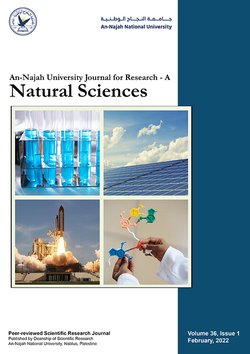Using Molecular and Biological Tools for Assessment of TYLCV Resistant Tomato Cultivars Commercially Grown in Southern Palestine
Authors:
Article info
2013-02-10
2014-01-26
2014-01-26
85 - 108
Keywords
Abstract
Tomato, considered one of most important and popular crop, was infected by Tomato Yellow Leaf Curl Virus (TYLCV) which causes significant yields loss. Biological and molecular tools were used to evaluate the TYLCV incidence on tomatoes grown under commercial conditions. A total number of 72 tomato plants from each eight different tomato cultivars commercially planted in Palestine were tested for their virus infection which occurred naturally. The virus incidence was reported biologically based on visual inspections for the disease symptoms and molecularly by PCR tests, in two growing season periods: Summer (2006) and spring (2007). As a result, no cultivars were found “immune” to virus infection. However, fundamental differences in symptoms development and severity had been discovered. This study, which was carried out for the first time in Palestine, showed that some cultivars such as “3060” could be targeted as promising virus-tolerant ones. The sensitivity of molecular methods over bioassays was evaluated, and combined methods were suggested for any cultivars resistance assessments. Besides, research results revealed that the experimental conditions in Spring were not in favor of the virus spread, as the main virus vector (Bemisia tabaci) population number would be lower in the Summer season; thus the Spring season is seen as the best one for farmers to escape from TYLCV infections.
Amro, S., Alkowni, R., & Hamdan, A.-J. (2014). Using Molecular and Biological Tools for Assessment of TYLCV Resistant Tomato Cultivars Commercially Grown in Southern Palestine. An-Najah University Journal for Research - A (Natural Sciences), 28(1), 85–108. https://doi.org/10.35552/anujr.a.28.1.993
[1]S. Amro, R. Alkowni, and A.-J. Hamdan, “Using Molecular and Biological Tools for Assessment of TYLCV Resistant Tomato Cultivars Commercially Grown in Southern Palestine,” An-Najah University Journal for Research - A (Natural Sciences), vol. 28, no. 1, pp. 85–108, Jan. 2014, doi: 10.35552/anujr.a.28.1.993.
Amro, Sahar, et al. “Using Molecular and Biological Tools for Assessment of TYLCV Resistant Tomato Cultivars Commercially Grown in Southern Palestine.” An-Najah University Journal for Research - A (Natural Sciences), vol. 28, no. 1, Jan. 2014, pp. 85–108. Crossref, https://doi.org/10.35552/anujr.a.28.1.993.
1.Amro S, Alkowni R, Hamdan AJ. Using Molecular and Biological Tools for Assessment of TYLCV Resistant Tomato Cultivars Commercially Grown in Southern Palestine. An-Najah University Journal for Research - A (Natural Sciences) [Internet]. 2014 Jan;28(1):85–108. Available from: http://dx.doi.org/10.35552/anujr.a.28.1.993
Amro, Sahar, Raed Alkowni, and Abdul-Jalil Hamdan. “Using Molecular and Biological Tools for Assessment of TYLCV Resistant Tomato Cultivars Commercially Grown in Southern Palestine.” An-Najah University Journal for Research - A (Natural Sciences) 28, no. 1 (January 2014): 85–108. https://doi.org/10.35552/anujr.a.28.1.993.
استخدام الأدوات الجزيئية والبيولوجية لتقييم أصناف البندورة المقاومة لفيروسTYLCV والمستعملة تجاريا في جنوب فلسطين
المؤلفون:
معلومات المقال
2013-02-10
2014-01-26
2014-01-26
85 - 108
الكلمات الإفتتاحية
الملخص
تعتبر البندورة واحدة من المحاصيل المهمة والشعبية، ولكنها تصاب بفيروس تجعد واصفرار اوراق البندورة (TYLCV) مما يسبب خسارة كبيرة في الانتاج. تم استخدام الأدوات البيولوجية والجزيئية لتقييم الإصابة على البندورة والتي نمت في الظروف التجارية. تم اختبار 72 من نبات الطماطم لكل صنف من الأصناف الثمانية للطماطم المختلفة والمستعملة تجاريا في فلسطين، وذلك بفحص اصابتها بالفيروس المنتقل اليها بشكل طبيعي. حيث تم ثبوت وقوع الاصابة الفيروسية بيولوجيا عن طريق عمليات التفتيش البصرية لأعراض المرض، وجزيئيا عن طريق اختبارات تضاعف الحمض النووي (PCR)، وذلك في موسمين: صيف (2006) وربيع (2007). وكانت النتيجة لذلك انه لا توجد "مناعة" لعدوى الفيروس لأي من الأصناف المختبرة. ومع ذلك، فقد كشفت الدراسة، والتي تجرى للمرة الأولى في فلسطين، اختلافات جوهرية في تطور المرض وشدة الاصابة. حيث أظهرت النتائج انه يمكن استهداف بعض الأصناف الواعدة مثل "3060" لكونها الاكثر تحملا للفيروس. تم كذلك تقييم حساسية الاختبارات الجزيئية مقارنة بمثيلاتها البيولوجية، واقتراح استعمال الاختبارين معا في تقييم أي أصناف مقاومة. اضافة الى ذلك، كشفت النتائج أن الظروف التجريبية في الربيع لم تكن في صالح انتشار الفيروس، حيث أن تعداد ناقلات الفيروس الرئيسة (الذبابة البيضاء) تكون أقل من موسم الصيف، مشيرة الى ان هذا الموسم هو الأفضل للمزارعين للهروب من الاصابة بالفيروس (TYLCV).
Amro, S., Alkowni, R., & Hamdan, A.-J. (2014). Using Molecular and Biological Tools for Assessment of TYLCV Resistant Tomato Cultivars Commercially Grown in Southern Palestine. An-Najah University Journal for Research - A (Natural Sciences), 28(1), 85–108. https://doi.org/10.35552/anujr.a.28.1.993
[1]S. Amro, R. Alkowni, and A.-J. Hamdan, “Using Molecular and Biological Tools for Assessment of TYLCV Resistant Tomato Cultivars Commercially Grown in Southern Palestine,” An-Najah University Journal for Research - A (Natural Sciences), vol. 28, no. 1, pp. 85–108, Jan. 2014, doi: 10.35552/anujr.a.28.1.993.
Amro, Sahar, et al. “Using Molecular and Biological Tools for Assessment of TYLCV Resistant Tomato Cultivars Commercially Grown in Southern Palestine.” An-Najah University Journal for Research - A (Natural Sciences), vol. 28, no. 1, Jan. 2014, pp. 85–108. Crossref, https://doi.org/10.35552/anujr.a.28.1.993.
1.Amro S, Alkowni R, Hamdan AJ. Using Molecular and Biological Tools for Assessment of TYLCV Resistant Tomato Cultivars Commercially Grown in Southern Palestine. An-Najah University Journal for Research - A (Natural Sciences) [Internet]. 2014 Jan;28(1):85–108. Available from: http://dx.doi.org/10.35552/anujr.a.28.1.993
Amro, Sahar, Raed Alkowni, and Abdul-Jalil Hamdan. “Using Molecular and Biological Tools for Assessment of TYLCV Resistant Tomato Cultivars Commercially Grown in Southern Palestine.” An-Najah University Journal for Research - A (Natural Sciences) 28, no. 1 (January 2014): 85–108. https://doi.org/10.35552/anujr.a.28.1.993.

Since 2019
Cite Score (Scopus): 0.8
Time to First Decision: 5 Days
Submission to Acceptance: 90 Days
Acceptance to Publication: 14 Days
Acceptance Rate: 22%
Call for Papers:
Sustainable Materials and Chemistry for Energy and Environmental Applications
Why should you
Publish With Us?
An-Najah National University
Nablus, Palestine
Nablus, Palestine
- P.O. Box
- 7, 707
- Fax
- (970)(9)2345982
- Tel.
- (970)(9)2345560
- (970)(9)2345113/5/6/7-Ext. 2628
- [email protected]
- EIC
- Prof. Waleed Sweileh
An-Najah University Journal for Research - A (Natural Sciences) by An-Najah University, Nablus, Palestine is licensed under CC BY-NC 4.0

